14 Trees to Beautify Your Front Yard
From flowering varieties to ones with four seasons of interest, these trees will take center stage in your landscape.
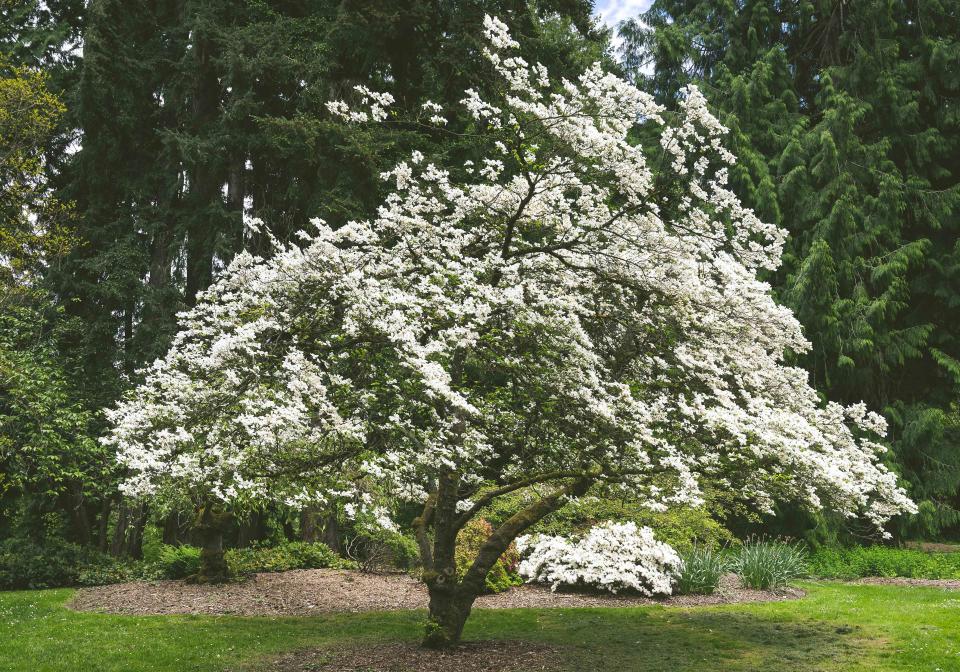
Cavan Images / Getty Images
Do you want to boost your home's curb appeal? Beyond updating your house's façade, refreshing your landscape is your next best bet. Everything from trimmed hedges to a freshly mowed lawn can enhance your home's appearance—but that's not all. An attractive tree in your front yard can add just as much beauty and value to your property. Ahead, we're sharing several front yard trees that can boost curb appeal and will quickly become the focal point of your home's exterior.
Meet the Experts
Jennifer Bolstad, RLA, a certified arborist and founder of Driftless Landscape Architecture
Adrienne Roethling, garden director for Paul J. Ciener Botanical Garden.
Related: 14 Flowers That Will Make Your Home the Prettiest on the Block
Juneberry
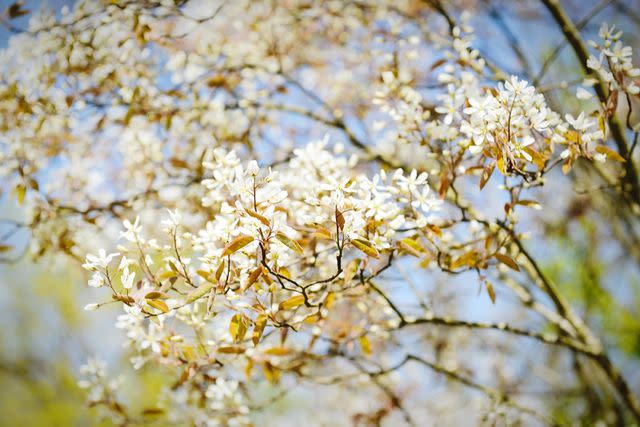
For a low-maintenance, versatile option, consider the juneberry tree (Amalanchier spp.). This small tree is tolerant of a range of growing conditions. "It requires little maintenance and offers interest throughout the seasons—soft white blossoms in the spring produce a berry-like fruit in June, as per the name," says Jennifer Bolstad, RLA, a certified arborist and founder of Driftless Landscape Architecture.
Come autumn, this tree's leaves become speckled with red, orange, apricot, or yellow—and in winter, the tree's bark is coated with subtle stripes and a calligraphic branching structure, says Bolstad.
Zones: 3 to 9
Size: 3 to 18 feet tall x 6 to 10 feet wide
Care requirements: Full sun to partial shade; well-draining clay soil
Golden Rain Tree
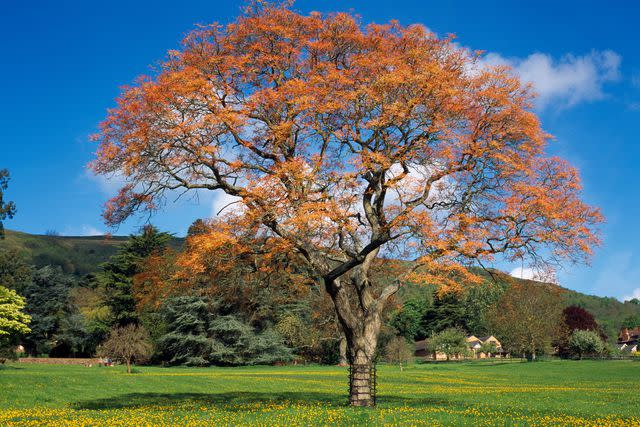
Eye Ubiquitous / Getty Images
If you have a small to medium yard, the golden rain tree (Koelreuteria paniculata) is a great choice. "It prefers full sun and is tolerant of a range of soil conditions and the stressors of urban sites," says Bolstad. "Its open branching structure and persistent, lantern-like seed pods provide winter interest." By the spring, feathery compound leaves will grow.
Zones: 5 to 9
Size: 30 to 40 feet tall x 30 to 40 feet wide
Care requirements: Full sun; well-draining clay soil
European Horse-Chestnut
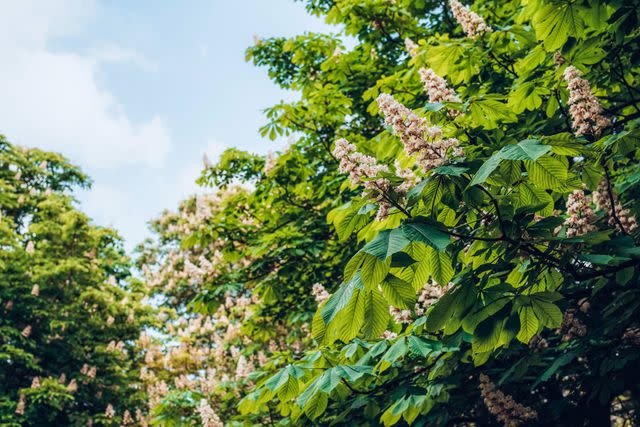
Perfect for a larger yard, European horse-chestnut (Aesculus hippocastanum) stands 70 feet tall and nearly 60 feet wide at full maturity. "Its graceful, upright, oval branching structure lends gravitas to your property in the winter," says Bolstad. Once spring arrives, stunning palm-shaped leaves with clusters of white flowers grow on the branches.
This tree has pros and cons: "While it provides habitat for a variety of birds and small mammals, it can be messy when it drops fruit in the fall," says Bolstad. "This is a plant that requires some light maintenance, but it will reward your efforts with its classic, timeless elegance."
Zones: 3 to 7
Size: 70 feet tall x 60 feet wide
Care requirements: Full sun to partial shade; heavy, well-draining soil
American Smoketree
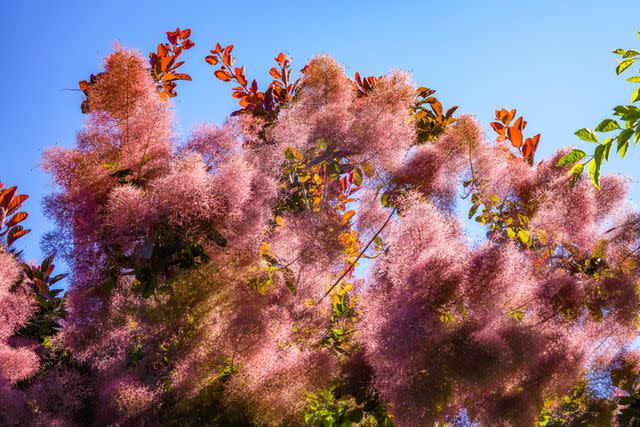
The American smoketree (Cotinus obovatus) is ideal for front yards that are small to medium in size. "The Smoketree is far less common than dogwoods, crabapples, and cherries, but no less spectacular in its show-stopping late spring display of flowers that look like fireworks (hence the name)," says Bolstad. "It offers vivid and varied fall colors that might range from yellow, to orange, to red, to deep purple—sometimes all on the same plant." Another winning feature is its scaly bark, which will add texture to your winter landscape.
Zones: 3 to 8
Size: 20 to 30 feet tall x 20 to 30 feet wide
Care requirements: Full sun; well-draining soil
Japanese Cryptomeria
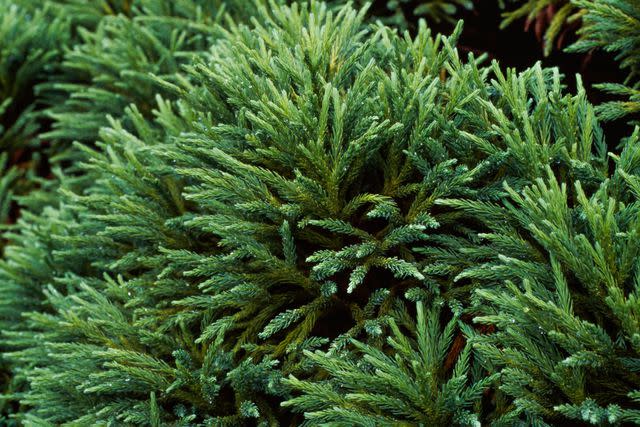
Opt for an evergreen like the Japanese cryptomeria (Cryptomeria japonica) if you're looking for a variety that requires minimal upkeep. "Its distinctive foliage has a fluffy texture and is soft to the touch, with the lustrous blue-green needles cladding foxtail-like branches," says Bolstad. "In the coldest extent of its range, the needles can turn bronze or purple." It doesn't tolerate harsh winter winds, so plant it in an area that offers some protection from inclement weather.
Zones: 5 to 9
Size: 50 to 70 feet tall x 20 to 30 feet wide
Care requirements: Full sun to partial shade; moist, well-draining soil that is slightly acidic
'Sweet Tea' Mountain Gordilinia
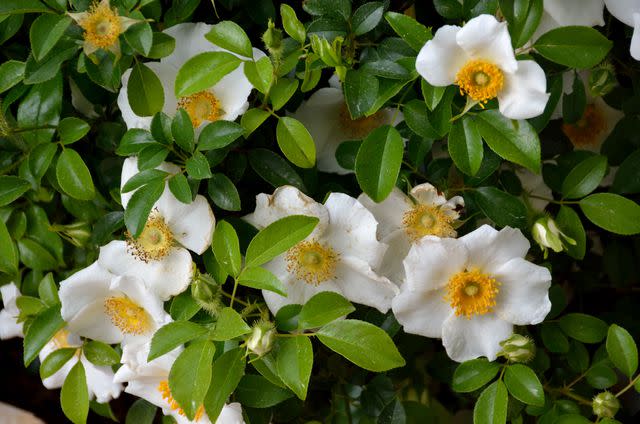
Paulbr / Getty Images
An amazing hybrid between two North American trees, 'Sweet Tea' mountain gordlinia offers four seasons of interest. It produces tea-like flowers in summer for several weeks to months. "Flowers in the tea family feature five-petaled white flowers with bright yellow centers; however, 'Sweet Tea' flowers are much larger—up to 6 inches across," says Adrienne Roethling, garden director for Paul J. Ciener Botanical Garden. "The new growth emerges with a purple hue, changing to emerald green in summer and red in fall."
Zones: 7 to 9
Size: 20 to 30 feet tall x 10 to 15 feet wide
Care requirements: Full sun to partial shade; moist, well-draining soil
Chinese Fringe Tree
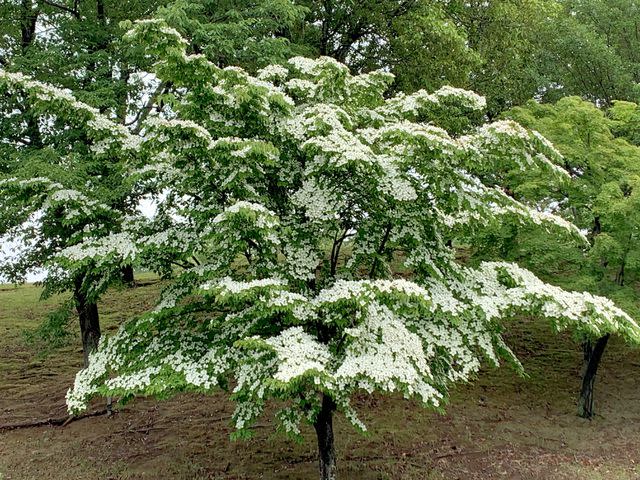
Getty Images
Chinese fringe tree (Chionanthus retusus) produces mid-spring clouds of narrow white petals and shiny green leaves that wake up along with the blooms. "The bark creates this alligator skin appearance, which is quite attractive in fall and winter when the leaves drop," says Roethling. One issue you may encounter with this tree is leaf spot during wet springs, but most leaves affected will drop, allowing healthier leaves to shine on.
Zones: 5 to 9
Size: 30 feet tall x 20 feet wide
Care requirements: Full sun; well-draining soil
Banana Shrub
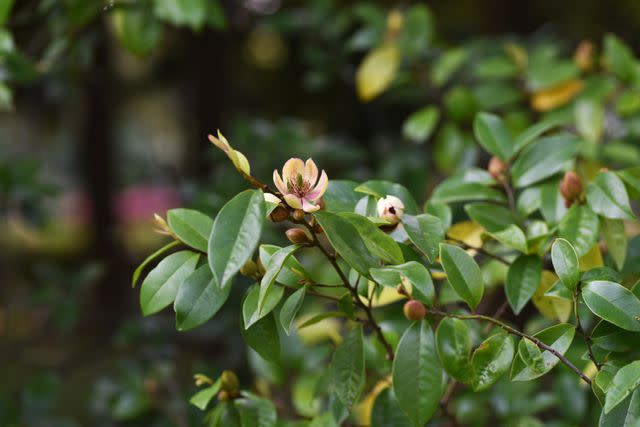
Getty Images
Banana shrub (Magnolia figo) has a lot going for it—multiple seasons of appeal, evergreen leaves, fragrant and showy flowers, and cinnamon-colored buds. "It can be left to branch low like a shrub or limbed up to make a small tree," says Roethling. The fuzzy buds open in May and smell just like bananas. To enjoy the fragrance from inside your home, plant this tree close to a window or doorway.
Zones: 7 to 9
Size: 15 feet tall x 7 feet wide
Care requirements: Full sun; average soil
Related: The 11 Most Fragrant Flowers to Plant in Your Garden
Red Lotus Tree
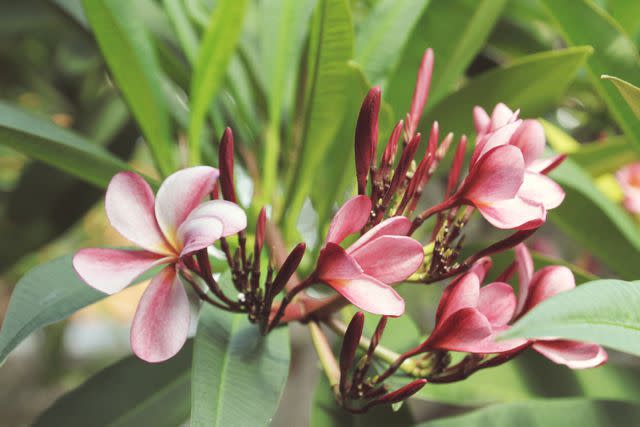
Isabel Pavia / Getty Images
Red lotus tree (Magnolia insignia) is an ideal plant to add as a centerpiece or focal point behind a mass of perennials. "In early summer, white, balloon-shaped buds will gradually open with reddish tones," says Roethling. "It’s a magnolia, therefore expect that soft perfume scent to permeate the afternoon air."
Zones: 7 to 9
Size: 25 to 30 feet tall x 10 to 15 feet wide
Care requirements: Full sun to partial shade; well-draining soil
Fragrant Snowbell
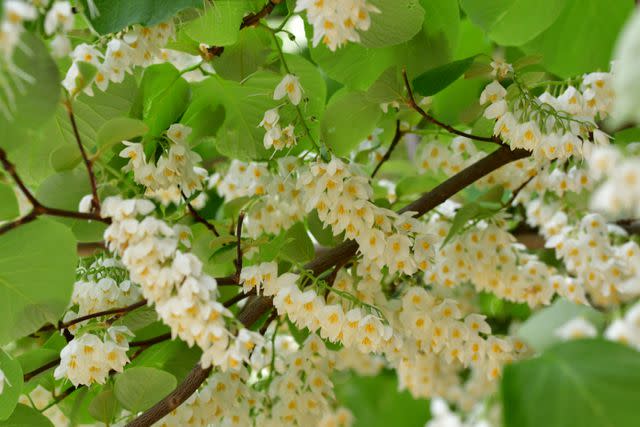
Getty Images
Fragrant snowbell (Styrax japonicus) is a small deciduous tree with extremely fragrant white spring flowers. "The flowers are little but cover every limb from head to toe," says Roethling. "It’ll make a wonderful statement as a stand-alone or in the back of a perennial bed." Its grey bark and gumdrop-like shape give the tree interest during winter months.
Zones: 5 to 9
Size: 30 feet tall x 20 feet wide
Care requirements: Full sun to partial shade; well-draining soil
Crepe Myrtle
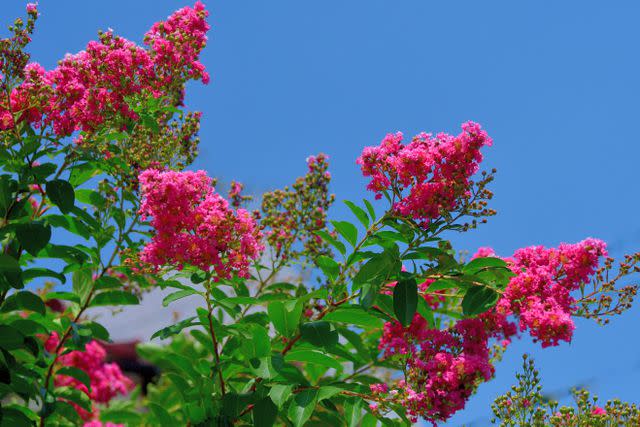
LITTLE DINOSAUR / Getty Images
One of the best performers during hot, dry summers is crepe myrtle (Lagerstroemia spp.). "With so many to choose from, one can find the right color and size to best suit their garden," says Roethling. "It’s one of the last summer flowering trees to leaf out. In June, July, and August, large panicles burst—from white to many shades of red and purple." In fall, some leaves are orange, and the panicles go from flowers to small, rounded capsules. Crepe myrtle offers winter interest thanks to its cinnamon-brown bark that exfoliates and intensifies in color.
Zones: 6 to 9
Size: 6 to 30 feet tall x 6 to 30 feet wide
Care requirements: Full sun; moist, well-draining soil
Chinese Snowball Viburnum
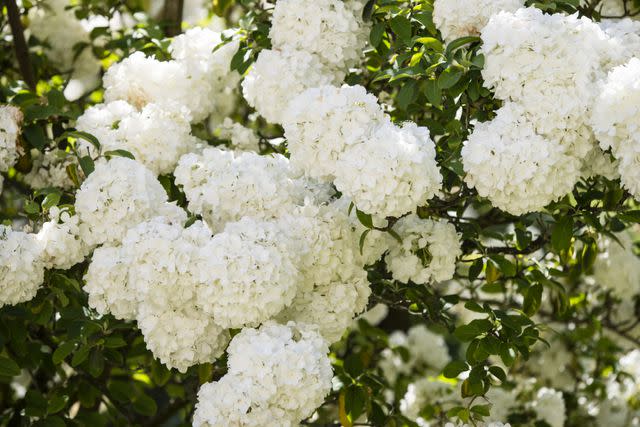
AlessandroZocc / Getty Images
Often confused for a hydrangea, Chinese snowball viburnum (Viburnum macrocephalum) is a showstopper in the front yard. "In late spring, large white flowers cover the plants so long as they are not in too much shade," says Roethling. "Some re-flowering can occur in fall. The flowers come out green and, when fully open, brighten to a giant white, snowball-like inflorescence." This tree variety does well with pruning should it begin to outgrow its space.
Zones: 6 to 10
Size: 6 to 25 feet tall x 10 to 20 feet wide
Care requirements: Full sun; well-draining soil
'Bloodgood' Japanese Maple
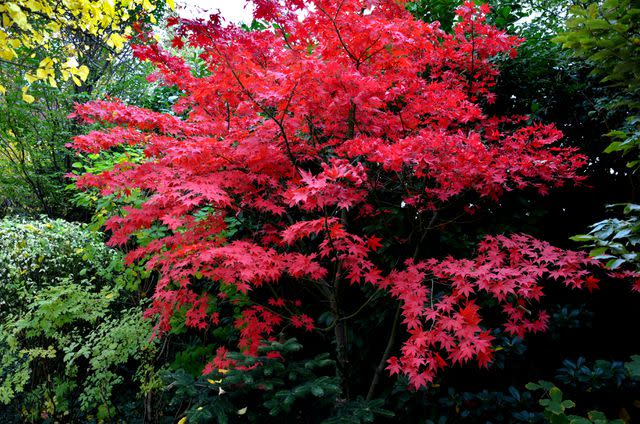
beekeepx / Getty Images
Japanese maples have unparalleled curb appeal and one particularly eye-catching variety is 'Bloodgood.' "It’s a wider spreading Japanese maple and the branching is quite gnarly looking in winter," says Roethling. "New leaves emerge in mid-spring to a coppery red tone before turning burgundy red for the summer." In fall, the palmate-shaped leaves turn a beautiful crimson color.
Zones: 5 to 9
Size: 15 feet tall x 20 feet wide
Care requirements: Full sun to part shade; rich, well-draining soil
Dogwood
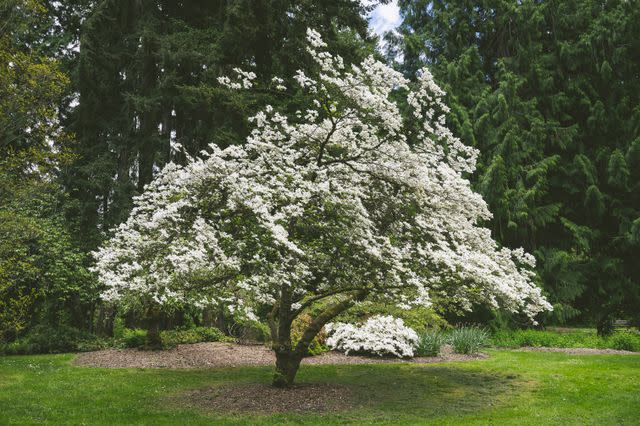
Cavan Images / Getty Images
Flowering dogwood (Cornus florida) boats beautiful white, yellow, or pink flowers in early spring. Native to eastern North America, the blooms on this understory tree will attract butterflies and bees to your yard, while songbirds come to snack on its red fruits, which appear from fall throughout winter. Commonly found in woodland margins, flowering dogwood can be challenging to grow in a landscape setting, but its beauty is well worth the extra effort.
Zones: 5 to 9
Size: 15 to 25 feet tall x 15 to 30 feet wide
Care requirements: Full sun to partial shade; well-draining soil
Related: 15 Pollinator Plants That Will Attract Birds, Bees, and Butterflies to Your Garden
Read the original article on Martha Stewart.

